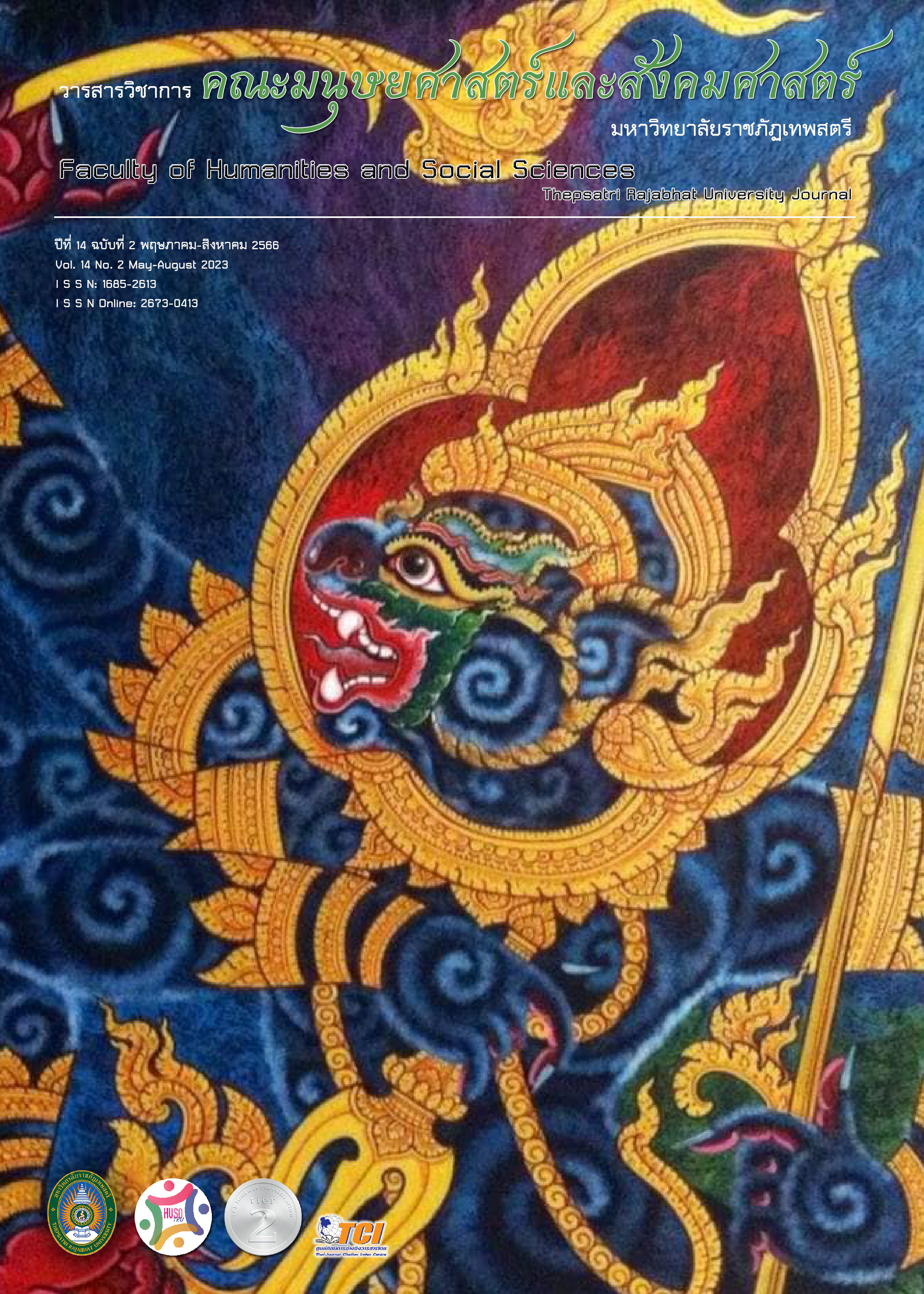การศึกษาความพึงพอใจต่อการออกแบบสื่อสร้างสรรค์สองภาษาเพื่อการเรียนรู้ เรื่อง ชุมชนไทยเบิ้ง บ้านโคกสลุง จังหวัดลพบุรี
Main Article Content
บทคัดย่อ
งานวิจัยนี้มีวัตถุประสงค์เพื่อศึกษาความพึงพอใจต่อการออกแบบสื่อสร้างสรรค์สองภาษาเพื่อการเรียนรู้ เรื่อง ชุมชนไทยเบิ้ง บ้านโคกสลุง ซึ่งออกแบบเป็นสื่อวีดิโอภาษาจีนและภาษาไทย กลุ่มเป้าหมายที่ใช้ในการวิจัยนี้ แบ่งออกเป็น 3 กลุ่ม ได้แก่ กลุ่มที่ 1 คือ นักศึกษาสาขาวิชาภาษาจีน คณะมนุษยศาสตร์และสังคมศาสตร์ที่ศึกษาในรายวิชาภาษาจีนเพื่อการท่องเที่ยว จำนวน 24 คน กลุ่มที่ 2 คือ นักท่องเที่ยวชาวจีนที่เคยเดินทางไปท่องเที่ยวชุมชนไทยเบิ้ง บ้านโคกสลุง จำนวน 2 คน และ กลุ่มที่ 3 คือ ผู้มีส่วนได้ส่วนเสีย ซึ่งเป็นผู้นำชุมชนและประชาชนในชุมชนไทยเบิ้ง จำนวน 5 คน กลุ่มเป้าหมายทั้ง 3 กลุ่มได้มาจากการเลือกแบบเจาะจง เครื่องมือที่ใช้ในการวิจัย ได้แก่ แบบประเมินความพึงพอใจในการออกแบบสื่อสร้างสรรค์สองภาษาเพื่อการเรียนรู้ ชุดชุมชนไทยเบิ้งบ้านโคกสลุงโดยตามแบบ ADDIE MODEL สถิติที่ใช้ในการวิจัย คือ ค่าเฉลี่ย และค่าเบี่ยงเบนมาตรฐาน ผลการวิจัยพบว่า ในภาพรวมผู้ตอบมีความพึงพอใจอยู่ในระดับมากที่สุด ค่าเฉลี่ยเท่ากับ 4.55 และมีค่า S.D. เท่ากับ 0.51 คิดเป็นร้อยละ 91 โดยรายการที่มีความพึงพอใจมากที่สุดคือ การนำสื่อไปใช้หรือเผยแพร่ไม่ซับซ้อน เหมาะสมกับการนำไปประชาสัมพันธ์เพื่อส่งเสริมการท่องเที่ยวให้แก่ชุมชน อันดับรองลงมาคือ รูปแบบการนำเสนอของสื่อมีความน่าสนใจ ดึงดูดให้เข้ามาท่องเที่ยวในชุมชนไทยเบิ้ง บ้านโคกสลุง และอันดับที่สามคือความพึงพอใจ ในภาพรวมหลังใช้สื่อสร้างสรรค์ชุดนี้
Downloads
Article Details

อนุญาตภายใต้เงื่อนไข Creative Commons Attribution-NonCommercial-NoDerivatives 4.0 International License.
เนื้อหาและข้อมูลในบทความที่ตีพิมพ์ในวารสารวิชาการคณะมนุษยศาสตร์และสังคมศาสตร์ มหาวิทยาลัยราชภัฏเทพสตรี ถือเป็นข้อคิดเห็นและความรับผิดชอบของผู้เขียนบทความโดยตรง ซึ่งกองบรรณาธิการวารสารไม่จำเป็นต้องเห็นด้วย หรือร่วมรับผิดชอบใดๆ
บทความ ข้อมูล เนื้อหา รูปภาพ ที่ได้รับการตีพิมพ์ในวารสารวิชาการคณะมนุษยศาสตร์และสังคมศาสตร์ มหาวิทยาลัยราชภัฏเทพสตรี ถือเป็นลิขสิทธิ์ของวารสารวิชาการคณะมนุษยศาสตร์และสังคมศาสตร์ มหาวิทยาลัยราชภัฏเทพสตรี หากบุคคลหรือหน่วยงานใดต้องการนำทั้งหมดหรือส่วนหนึ่งส่วนใดไปเผยแพร่ต่าหรือกระทำการใดๆ จะต้องได้รับอนาญาตจากวารสารวิชาการ ฯ ก่อนเท่านั้น
เอกสารอ้างอิง
ดวงกมล นามสองชั้น. (2565, มกราคม - เมษายน). สื่อมัลติมีเดียกับการสอนภาษาจีน. วารสารมหาวิทยาลัย ราชภัฏมหาสารคาม, 16(1), 1 - 12.
ทิศนา แขมมณี. (2555). 14 วิธีสอนสำหรับครูมืออาชีพ. กรุงเทพฯ: สำนักพิมพ์แห่งจุฬาลงกรณ์มหาวิทยาลัย.
แพรวพรรณ เกษรกุล. (2565, มกราคม - เมษายน). การสอนภาษาจีนผ่านทางสื่อออนไลน์ในประเทศไทย. วารสารครุศาสตร์ มหาวิทยาลัยราชภัฏมหาสารคาม, 19(1), 23 - 35.
ภูเทพ ประภากร. (2562). การพัฒนาผลสัมฤทธิ์ทางการเรียนในรายวิชาภาษาอาเซียนเพื่อการสื่อสารด้วยการเรียนการสอนแบบ Active Learning. เผยแพร่ในรายงานสืบเนื่องจากการประชุมวิชาการระดับชาติมหาวิทยาลัยราชภัฏกลุ่มศรีอยุธยา ครั้งที่ 10 “วิจัย นวัตกรรม นำการพัฒนาท้องถิ่น” ระหว่างวันที่ 4-5 กรกฎาคม พ.ศ. 2562 ณ มหาวิทยาลัยราชภัฏพระนครศรีอยุธยา (หน้า 188 – 193). พระนครศรีอยุธยา: มหาวิทยาลัยราชภัฏพระนครศรีอยุธยา.
สถาพร พฤฑฒิกุล. (2558). การจัดการเรียนการสอนแบบ Active Learning. สืบค้น พฤษภาคม 5, 2565, จาก https://km.buu.ac.th/article/frontend/article_detail/141.
สุไม บิลไบ. (2557). การออกแบบและพัฒนาบทเรียนมัลติมีเดีย. สืบค้น พฤษภาคม 5, 2565, จาก https://drsumaibinbai.files.wordpress.com/2014/12/addie_design_sumai.pdf.
ศศิณัฏฐ์ สรรคบุรานุรักษ์. (2560, กันยายน - ธันวาคม). สื่อมัลติมีเดียและเทคโนโลยีกับการสอนภาษาจีนในศตวรรษที่ 21. วารสาร Veridian E-Journal, Silpakorn University ฉบับภาษาไทย สาขามนุษยศาสตร์ สังคมศาสตร์ และศิลปะ, 10(3), 1239 – 1256.
Mckinney, S., E. (2008). Developing Teachers for High-poverty Schools: The Role of The Internship Experience. Urban Education, 43(1), 68 - 82. Retrieved May 20, 2022, from http://www.eric.ed.gor.


